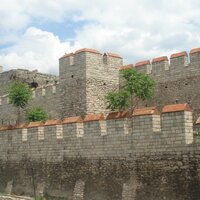Theodosian Walls of Constantinople
Type:
City walls
Date:
Fifth century
Location or Findspot (Modern-Day Country):
Turkey
Description:
The most extensive fortification walls for the city of Constantinople were built during the reign of Theodosius II (r. 408–50). The Theodosian Walls (sometimes also called the Theodosian Long Walls) were built approximately 2 km west of Constantine's walls. They were designed as more than simple walls, with the combined elements spanning a width of around 65 meters. Approaching from the outside, potential invaders faced a moat (7 m deep), a first wall with a patrol track and crenellated balustrade for archers, a second wall with towers and a a firing platform, and a massive third wall (12 m high) with 20-meter-high towers at regular intervals. The different sections were arranged on a rising embankment, with the moat was significantly lower than the inner walls. Gates provided official access to the city. Although the walls were damaged during many earthquakes, they withstood major sieges in 626 (Sasanians with Slav and Avar allies); 674–78 and 717 (Arabs); 821 (Slavs); and 860, 941, and 1043 (Rus'). It was not until 1453 that non-Christian (Turkish) forces broke through the walls.
Relevant Textbook Chapter(s):
2
Repository and Online Resources:
• See the location of the Theodosian Walls on the map of Byzantine Constantinople.
Image Credits:
Wikimedia Commons


